Seattle Jesuit College Hosts Unique Dharma Event
Written by: Steve Wilhelm
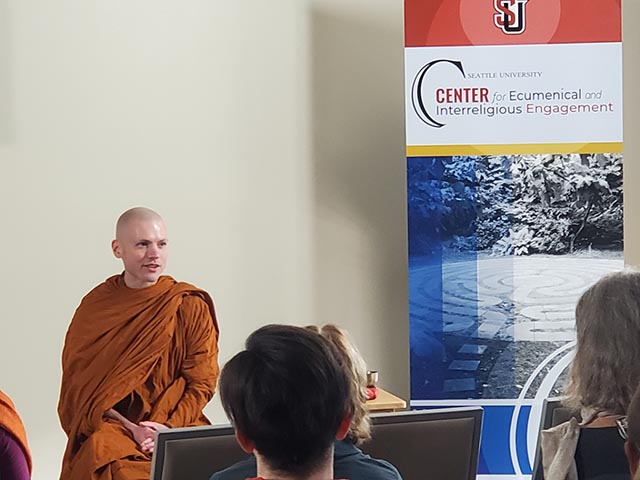
Ajahn Nisabho discussed how meditation can bring happiness to life.
Photos by: Steve Wilhelm
Three dharma teachers, from completely unrelated lineages, taught at Seattle University Oct. 27 in a unique and even historic event.
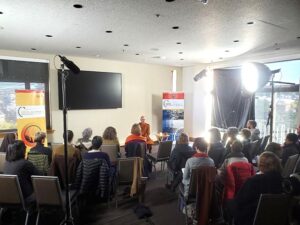
The event was unusual because Seattle University is a Jesuit Catholic school, not usually devoted to Buddhist dharma teachings. Also it was unusual because this was part of a three-year series, with a third set of talks planned for 2024.
“This is the second year we’re offering a dharma talk series. Last year our social media recorded thousands of people who were interested in learning more,” said Michael Trice, director of the Center for Ecumenical and Interreligious Engagement at Seattle University.
The center is coordinating the talks, at Trice’s initiative, to meet a need on-campus and off-campus.

“Where we are in the pandemic is people are yearning for more substance in their lives,” he said. “They need teaching that is directed toward them, that is addressing truthfully and honestly the kinds of suffering they see in the world.”
The Oct. 27 event featured three nationally and even globally-known Buddhist teachers. They taught in three-one hour segments, before an audience of about 50 people at Seattle University. The three segments were video recorded, to be released on the internet over the year.
“We decided that a second year of dharma talks, this time bringing respected teachers into one room in one day, and sharing this all across the year in video form,” Trice said, “was the best way of meeting that need.”
The first speaker was Ajahn Nisabho, a Western-born Theravada monk, who is co-abbot of Clear Mountain Monastery in Seattle. The title of his 10 a.m. talk was “How Dharma Practice Brings Inner Peace and Wisdom.”
Next was Bonnie Duran, a Buddhist teacher of Native American and Black descent, who also is a retired tenured professor from the University of Washington School of Social Work. Her talk was entitled “Burnout and Trauma.”
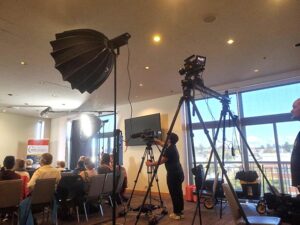
Last was Ven. Thubten Chodron, abbot of Sravasti Abbey in Newport, Washington, north of Spokane. Her 1 p.m. talk was entitled “Karma and Rebirth,” and she offered her talk just before boarding a flight for Singapore, to teach there.
The proceedings were recorded by a professional film crew, with some very complex camera gear. The center provided lunch during the noon break.
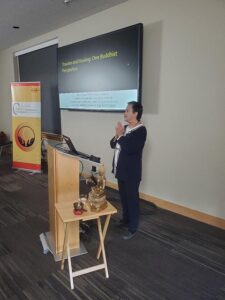
All three talks were focused on the needs of real 21st century people, and all of them sparked lively questions from the audience.
Ajahn Nisabho, in his talk about inner peace, articulated a way for people in the world to tap into the deep equanimity of a monastic, pointing out the unsatisfactoriness of doing otherwise.
“We know what a paltry existence middle class existence can be,” he said. “All beings feed, are constantly feeding, a losing game. The fundamental shift for any practitioner is the shift from feeding to not-grasping.”
The opposite of this entrapment can be the freedom that comes with meditation practice, which he said should be “playful.”
“The mind because it’s happy can see clearly, with less need to feed off those around us,” he said. “There’s a place for incorporating the wisdom the ancients used, with a light touch.”
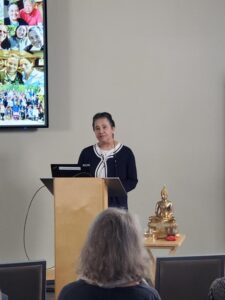
In her talk on trauma, Bonnie Duran explored how we’re traumatized by living in this world, by simply being born.
“When we’re traumatized, we get stuck in flight or fight,” she said, adding that this is accentuated by humans’ inherent negativity bias.
An antidote to staying stuck in trauma is cultivating mindfulness, which brings insight into the nature of things.
“The key to meditation is learning to stay” she said. “Mindfulness is more important for mental issues, than anything else.”
She ended by discussing the parallels between meditation practice and her traditional Native American practices.
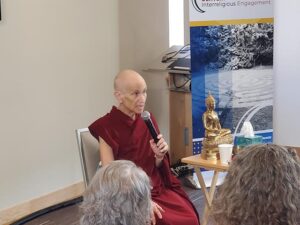
Ven. Thubten Chodron used her talk on rebirth and karma to explain the Buddhist idea that mind is more than an emergent quality of our physical bodies.
Rebirth gives a way of seeing life that is very expansive,” she said. “Life is when body and mind are associated. Death is when they’re no longer associated.”
Current views of most scientists are limited, she said.
“Mind is not matter, it didn’t come from matter, doesn’t go to matter,” she said. “Every moment of mind comes from a previous moment of mind.”
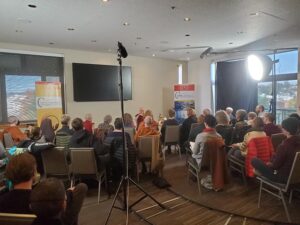
Ven. Chodron used this discussion as a way to encourage people to live with clean and positive thoughts.
How do we live our lives? Are we only centered around me, mine, my?” she said. “We have potential to develop impartial love and compassion, but it’s hard to do.”
But while it’s hard to make these changes, the alternative is worse.
“What is it that makes our life miserable, it’s our minds that make life miserable,” she said. “Being born and dying is like being on a merry-go-round. The greatest benefit is to bring others to awakening.”
Steve Wilhelm edits Northwest Dharma News, and serves on the boards of Tibetan Nuns Project and Friends of Clear Mountain Monastery. He teaches dharma through Seattle Insight Meditation Society, especially at Eastside Insight Meditation. A former journalist, he has edited five dharma books.
